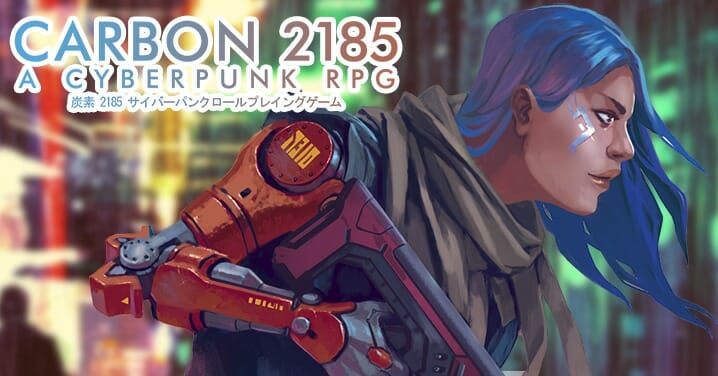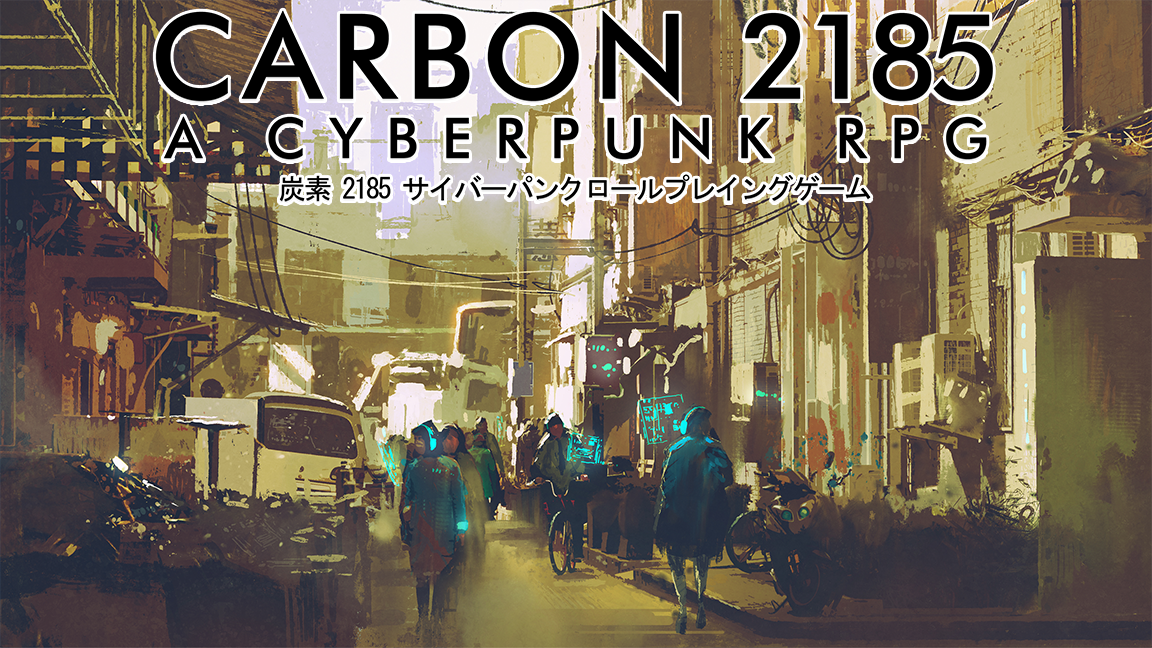I chose to write the review of Carbon 2185 – A Cyberpunk RPG because the Kickstarter campaign for Terminal Overdrive, a manual containing an adventure and additional content for this RPG recently and triumphantly concluded. Wanting to talk about that product, too, I thought I’d start from the heart of the game, the basic manual. It reached 1000% funding with over £140,000 in 2019. I was very happy to have been one of the 3100+ supporters of the project.
Carbon 2185 – A Cyberpunk RPG is, asits name states, a cyberpunk-themed role-playing game based on the CarbonRPG System (a reinterpretation of the D&D system based on the Open Game License by Dragon Turtle Games). The PDF is on sale on DriveThruRPG at $26,39, about 22€.
It was the year 2185…

The basic manual’s setting is the year 2185 in the city of San Francisco. There are expansions planned for additional cities of the future subject to future reviews. The common characteristics of the game world make up the backbone of the cyberpunk genre: cybernetic enhancements (first of all the neurolink, which allows you to connect with computers and similar), pollution, wealth and the concentration of power in the hands of a few mega-corporations.
Until 2019, we talk about our world and our history. After that, the fiction states that humanity has destroyed the global climatic balance (it would be more correct to say “continued to destroy”), has looked for resources outside our planet (many fertile planets have been discovered at the end of wormholes), the mega-corporations have replaced governments and made official their domination of once-sovereign countries, and Artificial Intelligence and androids have finally arrived.
Carbon 2185: review of art and layout

The art of Carbon 2185 makes the manual enjoyable just to browse (as the images included in this review attest). In my opinion, the image on the cover just doesn’t meet the standard of quality of some others in the manual, although it bears the signature of the great artist Klaus Wittmann. Colors and images are not present on every page and sometimes you miss them but, when they are, it is really a pleasure. A kaleidoscope of situations with more nuanced backgrounds created by brushstrokes are contrasted against drawings of characters and objects as varied as they are realistic.
The layout focuses above all on clarity. The few frills in the text allow for ease of reading. Clever use of italics and bolding in an above-average font size make it eye-catching. The manual holds up well. A few more touches of color and a few tricks to identify certain pages or sections would only have been icing on the cake.
Still D&D5e or not?
The D20 is still there, don’t worry. The work of game designer Robert Marriner-Dodds manages to be brilliant without giving up the original spirit of the game system. Class, level, proficiency, saving throws, it’s all there. Then, of course, we have changes of varying degrees to emphasize this clear change of setting. Being a human-centered world, races have been replaced by Origins: good-bye Wisdom and Charisma and welcome Technology and People. The first represents the ability to interact with technology and the second with people, at least with their non-synthetic parts.
rmor provides damage reduction from ballistic damage, while it’s a Reflex Save that prevents you from being hit by automatic fire. The 20th level is not just a wet dream but an impossible goal, since the maximum attainable level is 10th. These are some examples of how they adapted the system to a world where dragons are tattooed on peoples’ arms and dungeons are used to produce drugs or to satisfy low instincts.
Cyber in the D20 world

Historically, as far as I can remember (correct me if I’m wrong), there are other dice more used in the cyberpunk genre. The combination created by Carbon 2185 between the most-used system in the world and the pillars of the cyberpunk role-playing game is not perfect (which game is?), but it IS functional.
Hacking is simpler than many other games of the same genre, stealing some of the charm from hackers, but also taking some of the downtime away from other characters.. Tech augmentations take a little from magical items, with body slots, and levels partitioned to allow ever more powerful technologies. The cost is not the loss of humanity or empathy. A little philosophy and a lot of practice: augmentations intoxicate those who have them and Constitution is the key feature to be able to take on ever more powerful ones. Defects? The list is a bit sparse. In the end, it is one of the most iconic aspects of the game and, personally, I would have provided more variety to the players. It is also true that supplements exist for a reason.
Character creation in Carbon 2185

Character creation is very fluid and allows you easy access to all the typical characters of the cyberpunk genré. Characteristics are calculated with 2d6 + 5 and, in addition to Origins and Classes (I’ll list those shortly), there are two other structural elements: Vices and Backgrounds.
The former, consistent with the dystopian future of the world, generates an interpretative touch (but not only) that tells of addictions, psychoses and other dark aspects of humanity. A nice list of 100 detours serve to bridge the time between the end of the compulsory period of education (up to 18 years) and the beginning of the character’s story. You can choose up to five contracts, each lasting five years. You can also choose the same multiple times. Each involves a remuneration in cryptocurrencies, various skills and a gift at the end of the contract, but also the risk of being injured carrying various consequences. It reminds me of the Lifepath system of The Burning Wheel (but not only …), a game of which I have a high opinion and every detail that recalls it is a positive note to me.
Overall, I really enjoyed the creation of the character. One of the best results of bringing D&D5e to a new world not by distorting but by enriching and diversifying the proposal for players.
A bit of substance: some lists!
- Origins – Badlander, originally from the worst areas of civilization; Gutter Punks, the punk rocker of the future; Korporate Kids, orphans bought by multinationals as workforce or for other projects; Regular Joes, the “average” man, if there is one; Synth, the cool word for android; Wormer, from one of the space colonies.
- Classes – Daimyo, warrior, leader and paragon; Doc, because healers are universal; Enforcer, all-around fighter; Hacker, one of the most famous cyberpunk roles; Investigator, because even in the future you need to know how to discover people’s background and secrets; Scoundrel, because stealth never dies.
- Backgrounds – Corporate Drone, Criminal, Entertainer, Explorer, Laborer, Law Enforcement, Merchant, Technician, Unskilled Worker.

One city, one thousand groups
San Francisco, 12 million souls, is one of the most populous cities in the world. Most of the inhabitants live in micro-apartments of a few square meters. It is a labyrinth of neon lights and dark areas. The city is divided into 5 districts, ranging from a veritable hell to a paradise of future possibilities.
A list of brands in the city is very apt and fun, from the king of pizzas, Gaetano’s Italiano, to the main brands for the purchase of weapons, computers or space travel.
Carbon 2185 offers a large list of 19 corporations, 7 criminal organizations, 11 noteworthy groups. Each has its own space with a paragraph rich of contents.
The section that presents all this content, together with that concerning San Francisco, obviously represents the most interesting, fresh and original part of the manual, and also the one I liked the most – along with character creation.
Less sparkling (but certainly still very useful) is the next part of the manual, the “Game Master Dossier”: NPC Lists, Mission Generator, Loot Generator, Enemy Lists, the one that helps the storytellers create the stories and place the antagonists.
Carbon 2185 flaws
Where did you hide the index, guys? Where is it? We need help jumping from chapter to chapter to familiarize ourselves with the new rules and we need an index!
The introductory adventure included in the manual, Chow’s Request, is a bit poor. I was expecting more – a lot more. Science fiction/fantasy generally embodies worlds that follow a canon in which there is often very little to explain, usually allowing you to dive into play immediately. The cyberpunk world is more difficult, as it involves a future that doesn’t really have a precise canon and which is the result of centuries that each work and each game describes differently, producing markedly different settings. A wider adventure more focused on showcasing San Francisco in 2185 would have been masterful. It probably would have required a lot more space.
Finally, as I said for the cybernetic augmentations, the other lists of items, equipment and vehicles could also be fleshed out a bit, along with a few pages of rules and explanations. A little help for those who don’t chew cyberpunk would have been welcome, but we’re already talking about nearly 300 hard-working manual pages.
Final words on Carbon 2185

As you can read in this review, Carbon 2185 is a very good product. It forges a link between the best known system in the world and a fascinating genre. For many gamers, it can be a gateway to cyberpunk without the need to learn a new system. For others, it may bring a breath of freshness and practicality in a genre that has often seen cumbersome regulations.
Dragon Turtle Games did a great job on this manual, and the effort and attention that went into it are noticeable. In my opinion the experiment is a success. There are differences from D&D5e, but the system remains just that. There are strengths and weaknesses in the transition to a dystopian future, but the setting and the changes hold up well.
Next, I just have to venture out (and let you venture with me) and discover the supplements. Until then, I’ll dig into the latest manual released,Terminal Overdrive.


Trackbacks/Pingbacks